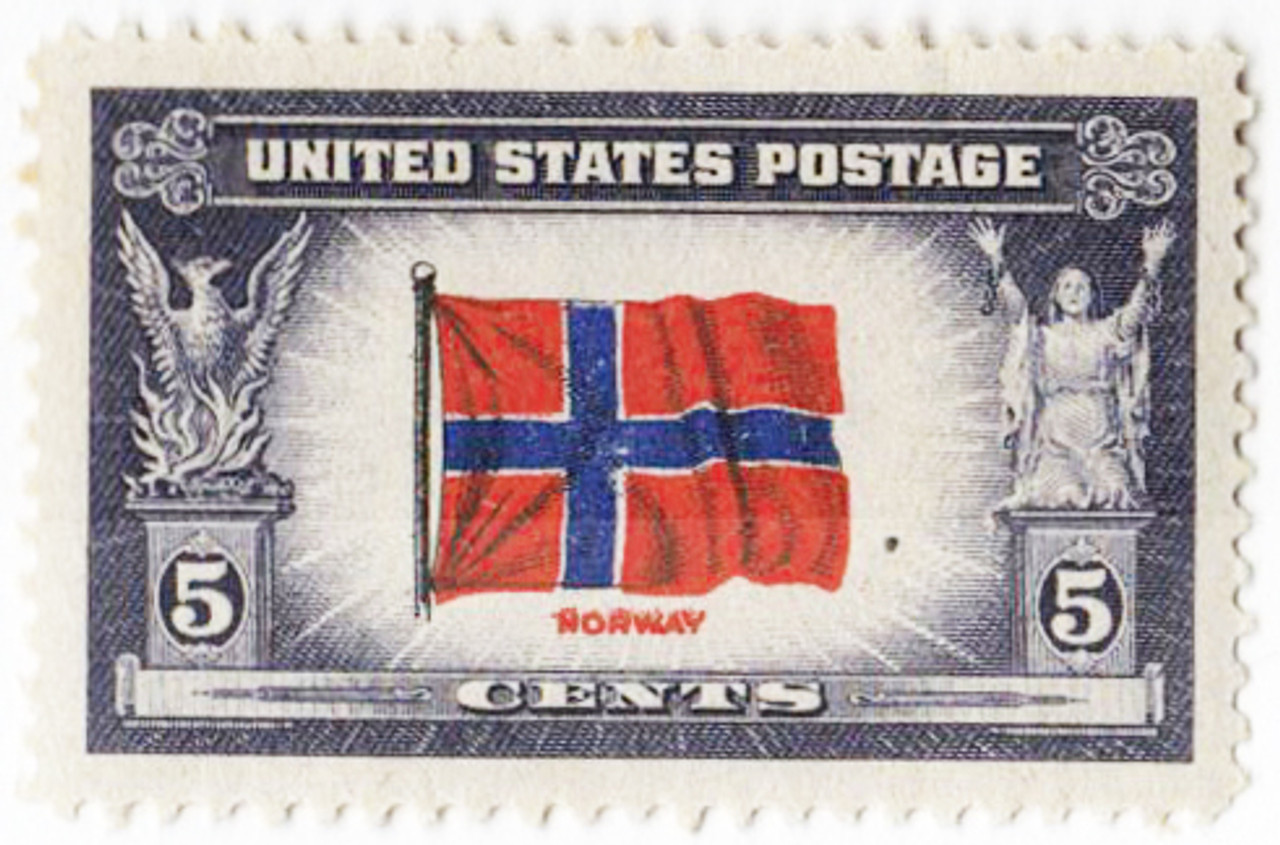
U.S. #911a- Double Impression of "Norway"
5¢ Flag of Norway
Overrun Countries Series
Issue Date: July 27, 1943
City: Washington, D.C.
Printed by: American Bank Note Company
Printing Method: Flat-Plate
Perforations: 12
Colors: Blue violet, dark rose, deep blue, and black
&nb... more
U.S. #911a- Double Impression of "Norway"
5¢ Flag of Norway
Overrun Countries Series
Issue Date: July 27, 1943
City: Washington, D.C.
Printed by: American Bank Note Company
Printing Method: Flat-Plate
Perforations: 12
Colors: Blue violet, dark rose, deep blue, and black
U.S. #911 is part of the Overrun Countries Series, which honors each of the nations invaded by Axis powers during World War II. It pictures the flag of Norway, which is red with a blue Scandinavian cross outlined in white. It was adopted in 1821.
Norway History
Norway remained mostly neutral during World War I, although they provided some assistance to Great Britain with its merchant fleet and by joining the trade blockade against Germany. Despite pronouncing their neutrality during World War II, Norway was invaded by Germany on April 9, 1940. Completely unprepared for the attack, they resisted for two months until forced to surrender when they lost British help due to the fall of France.
Germany occupied Norway for five years. The Norwegians formed their own resistance movement, fighting the German forces and destroying a heavy water plant that crippled the German nuclear capabilities. Once the war was over, Norway continued its alliances with Great Britain and the U.S. and went on to become one of the founding members of the North Atlantic Treaty Organization (NATO).
These Stamps Brought Hope to Overrun Countries of WW II
After receiving several designs from artists who felt the current U.S. postage stamps were unattractive, President Franklin Roosevelt began to consider the types of stamps he wanted to issue. He sought to show the world that America was in this war to achieve world peace, not military dominance. With this in mind, the President suggested the U.S. issue a series of stamps picturing the flags of all the overrun nations in Europe.
In the border surrounding each flag, Roosevelt suggested picturing the Phoenix – an ancient symbol of rebirth. He believed “It might tell those suffering victims in Europe that we are struggling for their own regeneration.” The other side of each flag pictured a kneeling woman “breaking the shackles of oppression.”
When the time came to print the stamps, the Bureau of Engraving and Printing was unable to print the multiple colors needed for each flag, so the American Bank Note Company received a special contract for this series.
Additionally, a 5¢ denomination – the foreign rate for first class postage – was chosen so the stamps could be used on overseas mail.
The stamps were printed in relatively small quantities and were in high demand as soon as they were issued, with stocks across the country running out almost as soon as they were released.
FDR – The Stamp-Collecting President
President Franklin Roosevelt was instrumental in the design and issuance of U.S. #911. Introduced to stamp collecting at a young age by his mother, Franklin Delano Roosevelt turned to his collection throughout his life to relax and unwind.
Elected President four times, Roosevelt served in the nation’s highest office longer than any other chief executive – 12 years. During those 12 years, Roosevelt shared his love of stamps with the nation, personally approving each of more than 200 stamp designs. He suggested topics, rejected others, and even designed some himself. It was his aim to use stamps not just to send mail but also to educate Americans about our history. And as he reluctantly entered America into World War II, he saw these stamps as an outlet to raise spirits and bring hope.












